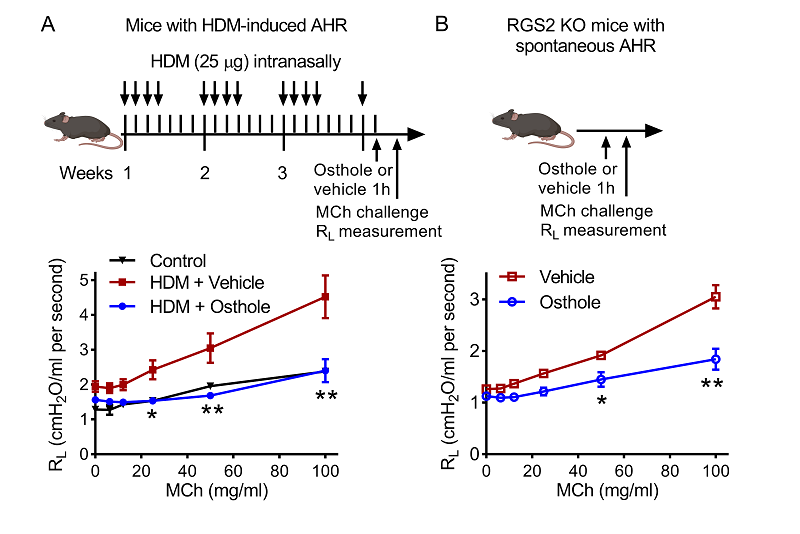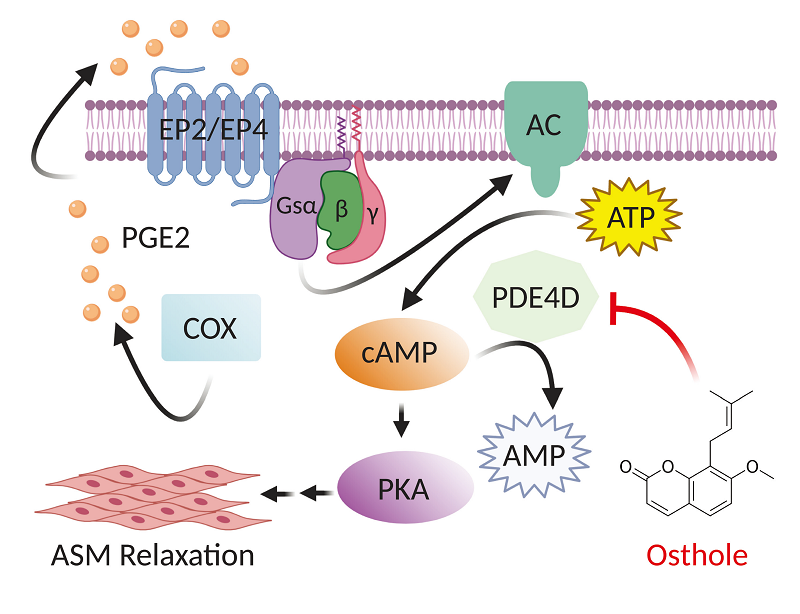Scientists revealed the Airway Relaxation Mechanisms of Osthole to Improve Lung Function in Asthma
Airway hyperresponsiveness (AHR) is one of the hallmarks of asthma, which is defined as increased sensitivity and reactivity of the airways to numerous types of stimuli that would produce little or no effect in healthy subjects. Clinically, asthma with intermittent symptoms is treated with β2-adrenoceptor agonists to relax airway smooth muscle (ASM). However, overuse of β2-adrenoceptor agonists induces β2-adrenoceptor desensitization that decreases bronchodilator efficacy, thus necessitating the identification of new agents to reverse unresponsive airway constriction.
Recently, an international cooperative study conducted by Prof. WEI Taotao from Institutes of Biophysics of Chinese Academy of Sciences, Prof. TU Yaping from Creighton University of USA and Prof. CAO Zhengyu from China Pharmaceutical University, revealed that osthole, a bioactive natural coumarin derived from the plant Cnidium monnieri, can induce ASM relaxation to inhibit AHR. More importantly, osthole can still maintain high bronchodilator efficacy in β2-adrenoceptor desensitization model.
In this study, the researchers proved that osthole directly targets phosphodiesterase 4D (PDE4D) to relax ASM in animal models, culture tissue slices and primary culture cells. Autocrine PGE2 by ASM cells can bind to EP receptors to activate PKA to induce ASM relaxation. However, PDE4D, the predominant isoform of PDE that controls airway constriction can catalyze the hydrolysis of cAMP to inhibit the activation of PKA to induce ASM contraction. According to the structure of PDE4D-osthole complex, osthole and cAMP share some same binding sites in PDE4D catalytic domain, and osthole should competitively prevent cAMP binding and hydrolysis. Thus, blockade of PDE4D activity by osthole increases intracellular cAMP levels with subsequent stimulation of PKA that leads to ASM relaxation.
These results uncovered a novel pharmacological function of osthole, as well as the complex regulation of ASM contraction and relaxation pathway.
The paper entitled " Airway Relaxation Mechanisms and Structural Basis of Osthole to Improve Lung Function in Asthma " has been published online in Science Signaling on November 24, 2020.

Figure 1. Osthole ameliorates AHR in HDM sensitized mice (A) and na?ve RGS2 KO mice (B).

Figure 2. Ribbon diagram of the monomeric PDE4D5 catalytic domain complexed with osthole (oxygen, red; carbon, yellow) (A). The chemical structure and electron density map of osthole (B). Osthole binding to the active site of PDE4D5 (C).

Figure 3. A proposed molecular mechanism underlying osthole-induced airway relaxation.
(Image by Dr. WEI Taotao's group)
Article Link: https://stke.sciencemag.org/content/13/659/eaax0273
Contact: WEI Taotao
Institute of Biophysics, Chinese Academy of Sciences
Beijing 100101, China
Email: weitt@ibp.ac.cn
(Reported by Dr. WEI Taotao's group)

